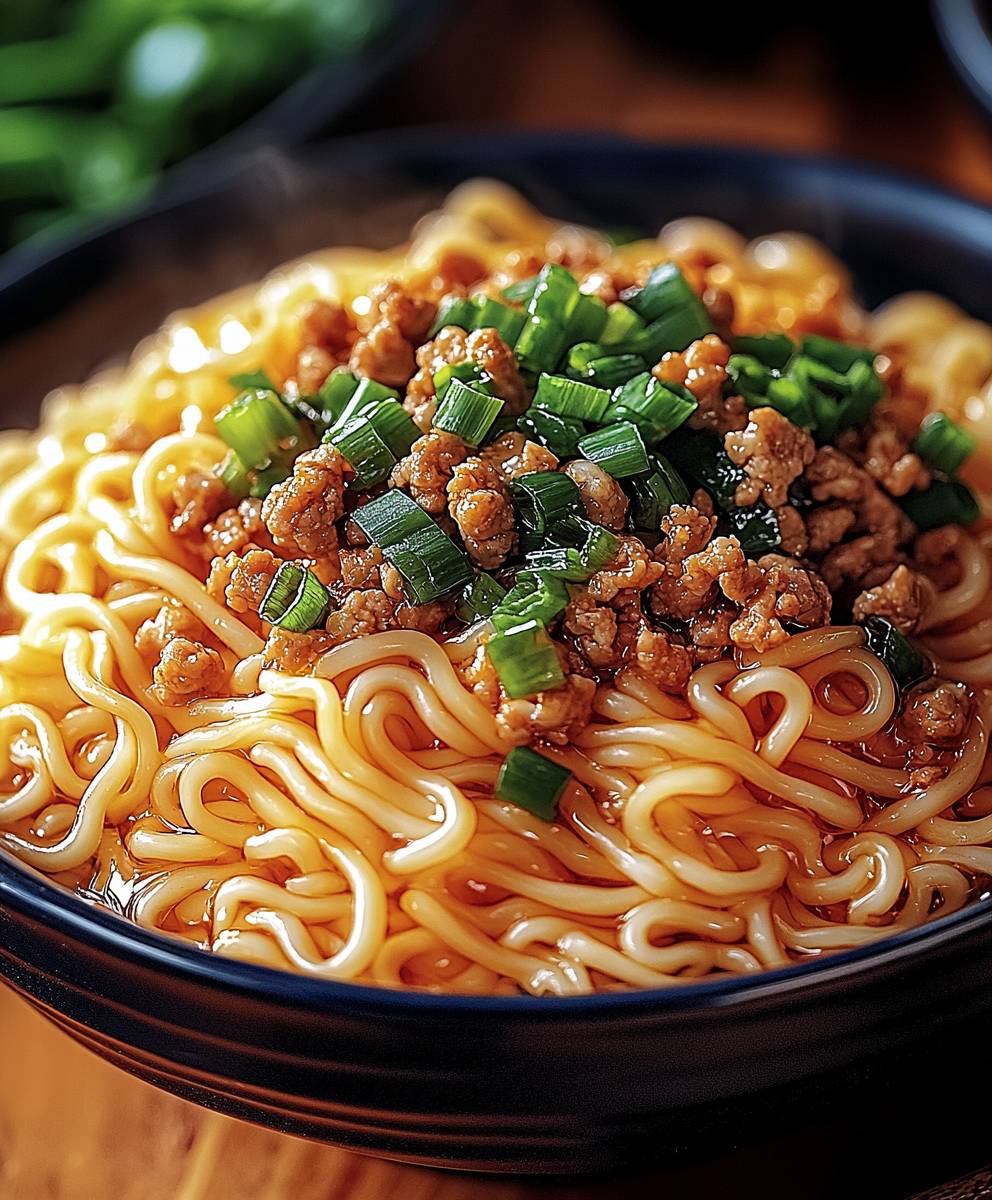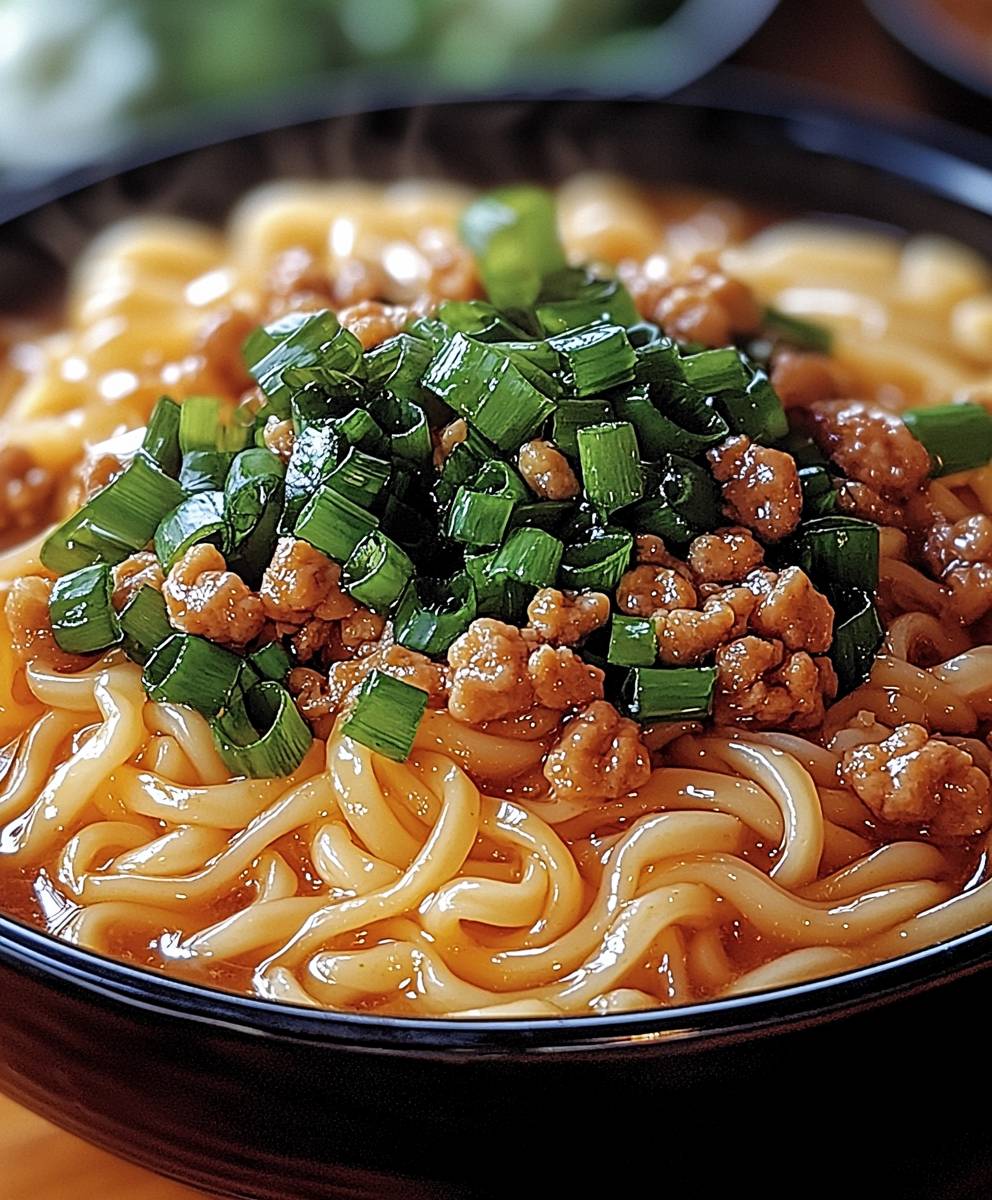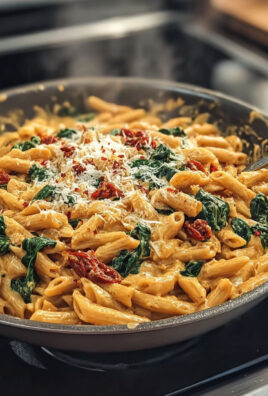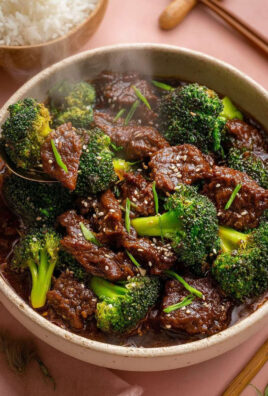Dan Dan Noodles, a culinary masterpiece hailing from the Sichuan province of China, are about to become your new favorite weeknight dinner. Imagine a bowl brimming with perfectly cooked noodles, swimming in a savory, spicy, and slightly sweet sauce, topped with crispy ground pork and fragrant aromatics. Intrigued? I thought you might be! This isn’t just a meal; it’s an experience.
The history of Dan Dan Noodles is as rich and flavorful as the dish itself. Legend has it that these noodles were originally sold by street vendors carrying them on a “dan dan” – a carrying pole – hence the name. These vendors would traverse the bustling streets of Sichuan, offering a quick, affordable, and incredibly satisfying meal to hungry passersby. Over time, the dish evolved, with each vendor adding their own unique twist, but the core elements of spice, savory depth, and textural contrast remained constant.
What makes Dan Dan Noodles so universally loved? It’s a symphony of flavors and textures that dance on your palate. The numbing heat of Sichuan peppercorns, the umami richness of the sesame paste, the satisfying chew of the noodles, and the crispy, savory pork all come together in perfect harmony. Plus, while it might seem intimidating, this recipe is surprisingly easy to make at home. So, ditch the takeout menu and get ready to embark on a culinary adventure. You won’t regret it!
Ingredients:
- For the Noodles:
- 1 pound dried Chinese egg noodles (or spaghetti as a substitute)
- Water for boiling
- For the Sauce:
- 2 tablespoons Sichuan peppercorns
- 4 tablespoons vegetable oil, divided
- 4 cloves garlic, minced
- 1 inch ginger, minced
- 1/4 cup Sichuan chili bean paste (doubanjiang)
- 2 tablespoons Chinese sesame paste (zhima jiang) or tahini
- 2 tablespoons light soy sauce
- 1 tablespoon dark soy sauce
- 1 tablespoon Chinese black vinegar (Chinkiang vinegar)
- 1 teaspoon sugar
- 1/4 cup chicken broth or water
- For the Topping:
- 1 pound ground pork
- 1 tablespoon Shaoxing rice wine
- 1 teaspoon light soy sauce
- 1/2 teaspoon ground white pepper
- 2 tablespoons vegetable oil
- 1/4 cup preserved Sichuan pickled mustard greens (zha cai), finely chopped (optional)
- 2 tablespoons roasted peanuts, chopped
- 2 tablespoons scallions, thinly sliced
- Chili oil, to taste (optional)
Preparing the Pork Topping:
This is a crucial step, as the pork topping adds a rich, savory element to the noodles. We want it to be flavorful and slightly crispy.
- Marinate the Pork: In a bowl, combine the ground pork with Shaoxing rice wine, light soy sauce, and white pepper. Mix well and let it marinate for at least 15 minutes. This will help tenderize the pork and infuse it with flavor.
- Cook the Pork: Heat 2 tablespoons of vegetable oil in a wok or large skillet over medium-high heat. Add the marinated pork and stir-fry, breaking it up with a spatula, until it’s browned and cooked through. This usually takes about 5-7 minutes. You want the pork to be slightly crispy, so don’t be afraid to let it brown a bit.
- Add Pickled Mustard Greens (Optional): If you’re using preserved Sichuan pickled mustard greens (zha cai), add them to the wok during the last minute of cooking. Stir-fry briefly to incorporate the flavors. The zha cai adds a unique salty and slightly sour flavor that complements the pork beautifully.
- Set Aside: Once the pork is cooked and slightly crispy, remove it from the wok and set it aside. We’ll use it later to top the noodles.
Making the Dan Dan Noodle Sauce:
The sauce is the heart and soul of Dan Dan Noodles. It’s a complex blend of flavors – spicy, savory, nutty, and tangy. Don’t be intimidated by the number of ingredients; each one plays a vital role in creating the perfect balance.
- Toast the Sichuan Peppercorns: In a dry skillet over medium heat, toast the Sichuan peppercorns for 2-3 minutes, or until fragrant. Be careful not to burn them. Toasting the peppercorns enhances their aroma and numbing sensation (ma la).
- Grind the Peppercorns: Once toasted, grind the Sichuan peppercorns into a fine powder using a spice grinder or mortar and pestle. Set aside. Freshly ground Sichuan peppercorns are essential for that authentic numbing sensation.
- Infuse the Oil: Heat 2 tablespoons of vegetable oil in a wok or small saucepan over low heat. Add the minced garlic and ginger and cook until fragrant, about 1-2 minutes. Be careful not to burn the garlic.
- Add Doubanjiang: Add the Sichuan chili bean paste (doubanjiang) to the wok and stir-fry for 1-2 minutes, until fragrant and the oil turns red. This step is crucial for releasing the flavor and aroma of the doubanjiang.
- Combine Sauce Ingredients: In a bowl, combine the ground Sichuan peppercorns, the infused oil and doubanjiang mixture, Chinese sesame paste (or tahini), light soy sauce, dark soy sauce, Chinese black vinegar, sugar, and chicken broth (or water). Whisk well until everything is thoroughly combined and the sauce is smooth. Taste and adjust the seasonings as needed. You might want to add more soy sauce for saltiness, vinegar for tanginess, or sugar for sweetness.
Cooking the Noodles:
The noodles should be cooked al dente – slightly firm to the bite. Overcooked noodles will become mushy and won’t hold the sauce well.
- Boil the Noodles: Bring a large pot of water to a rolling boil. Add the dried Chinese egg noodles and cook according to the package directions, usually about 5-7 minutes, or until al dente.
- Drain the Noodles: Once the noodles are cooked, drain them well in a colander. Don’t rinse them, as the starch on the noodles helps the sauce cling to them.
Assembling the Dan Dan Noodles:
Now comes the fun part – putting everything together! This is where you get to customize your noodles to your liking.
- Portion the Sauce: Divide the sauce evenly among serving bowls. The amount of sauce you use will depend on your preference, but I usually recommend about 2-3 tablespoons per serving.
- Add the Noodles: Add the cooked noodles to the bowls on top of the sauce.
- Top with Pork: Spoon the cooked pork topping over the noodles. Be generous!
- Garnish: Garnish with chopped roasted peanuts, thinly sliced scallions, and a drizzle of chili oil (if using).
- Mix and Serve: Before eating, mix the noodles, sauce, and toppings together thoroughly. This ensures that every bite is packed with flavor. Serve immediately and enjoy!
Tips for the Best Dan Dan Noodles:
- Use High-Quality Ingredients: The quality of your ingredients will significantly impact the flavor of your Dan Dan Noodles. Use good-quality soy sauce, vinegar, and sesame paste.
- Don’t Skip the Sichuan Peppercorns: Sichuan peppercorns are essential for the authentic numbing sensation (ma la) that is characteristic of Dan Dan Noodles.
- Adjust the Spice Level: Dan Dan Noodles can be quite spicy, so adjust the amount of chili bean paste and chili oil to your liking.
- Make it Vegetarian: To make vegetarian Dan Dan Noodles, substitute the ground pork with crumbled firm tofu or vegetarian ground meat.
- Prepare Ahead: You can prepare the sauce and pork topping ahead of time and store them in the refrigerator. This makes it easy to whip up a quick and delicious meal.
Variations:
- Sesame Paste Substitute: If you can’t find Chinese sesame paste (zhima jiang), you can use tahini as a substitute. However, the flavor will be slightly different.
- Vinegar Options: If you don’t have Chinese black vinegar (Chinkiang vinegar), you can use balsamic vinegar or rice vinegar as a substitute.
- Add Vegetables: Feel free to add other vegetables to your Dan Dan Noodles, such as blanched bok choy, spinach, or bean sprouts.
Serving Suggestions:
Dan Dan Noodles are delicious on their own, but they also pair well with other Chinese dishes, such as:
- Cucumber Salad
- Garlic Green Beans
- Wonton Soup
Conclusion:
This isn’t just another noodle dish; it’s a flavor explosion waiting to happen! The complex interplay of savory, spicy, and slightly sweet notes in these Dan Dan Noodles creates an unforgettable culinary experience. From the tingling Sichuan peppercorns to the rich sesame paste and the satisfying crunch of the preserved vegetables, every bite is a journey for your taste buds. Trust me, once you try this recipe, you’ll understand why it’s a staple in Sichuan cuisine and a beloved dish worldwide.
But why is this recipe a must-try, you ask? Well, beyond the incredible flavor profile, it’s surprisingly accessible. While it might seem intimidating at first glance, I’ve broken down the steps to make it manageable for even novice cooks. You don’t need to be a professional chef to create restaurant-quality Dan Dan Noodles in your own kitchen. Plus, the ingredients are readily available at most Asian grocery stores, and many can even be found in well-stocked supermarkets.
And the best part? It’s incredibly versatile! While I’ve provided a classic recipe, feel free to experiment and make it your own. For a vegetarian version, simply substitute the ground pork with crumbled tofu or mushrooms. You can also adjust the spice level to your liking by adding more or less chili oil. If you’re feeling adventurous, try incorporating other toppings like chopped peanuts, scallions, or even a fried egg for added richness.
Speaking of serving suggestions, these noodles are fantastic as a quick and satisfying lunch, a flavorful side dish, or even a light dinner. I personally love pairing them with a side of steamed greens or a refreshing cucumber salad to balance out the richness. And if you’re hosting a dinner party, Dan Dan Noodles are sure to impress your guests with their unique and authentic flavor.
Don’t be afraid to get creative with your presentation too! Serve them in individual bowls garnished with plenty of toppings for a visually appealing dish. You can even drizzle a little extra chili oil on top for an extra kick.
I truly believe that this recipe for Dan Dan Noodles is a game-changer. It’s a delicious, authentic, and relatively easy way to experience the vibrant flavors of Sichuan cuisine. So, what are you waiting for? Gather your ingredients, put on your apron, and get ready to embark on a culinary adventure.
I’m so excited for you to try this recipe and experience the magic of Dan Dan Noodles for yourself. Once you’ve made it, I’d love to hear about your experience! Did you make any modifications? What were your favorite toppings? Share your photos and stories in the comments below. Let’s create a community of Dan Dan Noodle enthusiasts! Happy cooking!
Dan Dan Noodles: Authentic Recipe and Cooking Guide
Spicy and savory Dan Dan Noodles with a rich pork topping and a numbing Sichuan peppercorn kick.
Ingredients
- 1 pound dried Chinese egg noodles (or spaghetti as a substitute)
- Water for boiling
- 2 tablespoons Sichuan peppercorns
- 4 tablespoons vegetable oil, divided
- 4 cloves garlic, minced
- 1 inch ginger, minced
- 1/4 cup Sichuan chili bean paste (doubanjiang)
- 2 tablespoons Chinese sesame paste (zhima jiang) or tahini
- 2 tablespoons light soy sauce
- 1 tablespoon dark soy sauce
- 1 tablespoon Chinese black vinegar (Chinkiang vinegar)
- 1 teaspoon sugar
- 1/4 cup chicken broth or water
- 1 pound ground pork
- 1 tablespoon Shaoxing rice wine
- 1 teaspoon light soy sauce
- 1/2 teaspoon ground white pepper
- 2 tablespoons vegetable oil
- 1/4 cup preserved Sichuan pickled mustard greens (zha cai), finely chopped (optional)
- 2 tablespoons roasted peanuts, chopped
- 2 tablespoons scallions, thinly sliced
- Chili oil, to taste (optional)
Instructions
- Prepare the Pork Topping:
- Marinate the Pork: In a bowl, combine the ground pork with Shaoxing rice wine, light soy sauce, and white pepper. Mix well and let it marinate for at least 15 minutes.
- Cook the Pork: Heat 2 tablespoons of vegetable oil in a wok or large skillet over medium-high heat. Add the marinated pork and stir-fry, breaking it up with a spatula, until it’s browned and cooked through (5-7 minutes). You want the pork to be slightly crispy.
- Add Pickled Mustard Greens (Optional): If using, add the zha cai to the wok during the last minute of cooking. Stir-fry briefly.
- Set Aside: Remove the pork from the wok and set aside.
- Make the Dan Dan Noodle Sauce:
- Toast the Sichuan Peppercorns: In a dry skillet over medium heat, toast the Sichuan peppercorns for 2-3 minutes, or until fragrant.
- Grind the Peppercorns: Grind the toasted peppercorns into a fine powder using a spice grinder or mortar and pestle. Set aside.
- Infuse the Oil: Heat 2 tablespoons of vegetable oil in a wok or small saucepan over low heat. Add the minced garlic and ginger and cook until fragrant, about 1-2 minutes.
- Add Doubanjiang: Add the Sichuan chili bean paste (doubanjiang) to the wok and stir-fry for 1-2 minutes, until fragrant and the oil turns red.
- Combine Sauce Ingredients: In a bowl, combine the ground Sichuan peppercorns, the infused oil and doubanjiang mixture, Chinese sesame paste (or tahini), light soy sauce, dark soy sauce, Chinese black vinegar, sugar, and chicken broth (or water). Whisk well until smooth. Taste and adjust seasonings.
- Cook the Noodles:
- Boil the Noodles: Bring a large pot of water to a rolling boil. Add the dried Chinese egg noodles and cook according to package directions (usually about 5-7 minutes), or until al dente.
- Drain the Noodles: Drain the noodles well in a colander. Do not rinse.
- Assemble the Dan Dan Noodles:
- Portion the Sauce: Divide the sauce evenly among serving bowls (about 2-3 tablespoons per serving).
- Add the Noodles: Add the cooked noodles to the bowls on top of the sauce.
- Top with Pork: Spoon the cooked pork topping over the noodles.
- Garnish: Garnish with chopped roasted peanuts, thinly sliced scallions, and a drizzle of chili oil (if using).
- Mix and Serve: Mix the noodles, sauce, and toppings together thoroughly. Serve immediately.
Notes
- Use high-quality ingredients for the best flavor.
- Don’t skip the Sichuan peppercorns for the authentic numbing sensation.
- Adjust the spice level to your liking.
- For vegetarian Dan Dan Noodles, substitute the ground pork with crumbled firm tofu or vegetarian ground meat.
- You can prepare the sauce and pork topping ahead of time and store them in the refrigerator.
- If you can’t find Chinese sesame paste (zhima jiang), you can use tahini as a substitute.
- If you don’t have Chinese black vinegar (Chinkiang vinegar), you can use balsamic vinegar or rice vinegar as a substitute.
- Feel free to add other vegetables to your Dan Dan Noodles, such as blanched bok choy, spinach, or bean sprouts.
- Dan Dan Noodles are delicious on their own, but they also pair well with other Chinese dishes, such as Cucumber Salad, Garlic Green Beans, or Wonton Soup.





